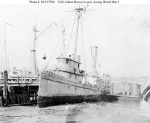Propulsion: One vertical boiler, one vertical steam engine, one shaft.
Click thumbnail
for full size image |
Size |
Image Description |
Source |
 |
110k |
Tied up to a pier during World War I
U.S. Navy photo NH 57784 |
Naval Historical Center |
 |
65k |
In port during World War I
U.S. Navy Photograph NH 90615 |
Dictionary of American Naval Fighting Ships: The wooden-hulled tug Albert Brown was acquired by the Navy from W. P. Orr, Jr., of Bristol, Maine, on 20 May 1917 and commissioned on 3 July 1917. Less than a month later, on 28 July 1917, Admiral William S. Benson, as Acting Secretary of the Navy, promulgated General Order No. 314 which decreed that all "scout patrol" vessels with compound names would hence forth be officially known by surname only. Thus Albert Brown (SP-1050) become simply >b>Browm (SP-1050) (q.v.), a name she used continually throughout her commissioned service.The 103-foot patrol and minesweeping tug, was built at Bristol, Maine, in 1875 as a steam fishing trawler. She was rebuilt in 1897 and remained active in the Menhaden fishery, operating out of Lewes, Delaware, until taken over by the Navy for World War I service. She served in the Delaware Bay area. In 1919 or early 1920, she was reported to be sunk at the Naval Air Station, Cape May, New Jersey, and was stricken from the Navy list in March 1920. After efforts to sell the wreck were unsuccessful, Albert Brown's remains were removed by Army Engineers. She was officially abandoned by the Navy in early 1923.
This page created by Joseph M. Radigan and maintained by David Wright

|

